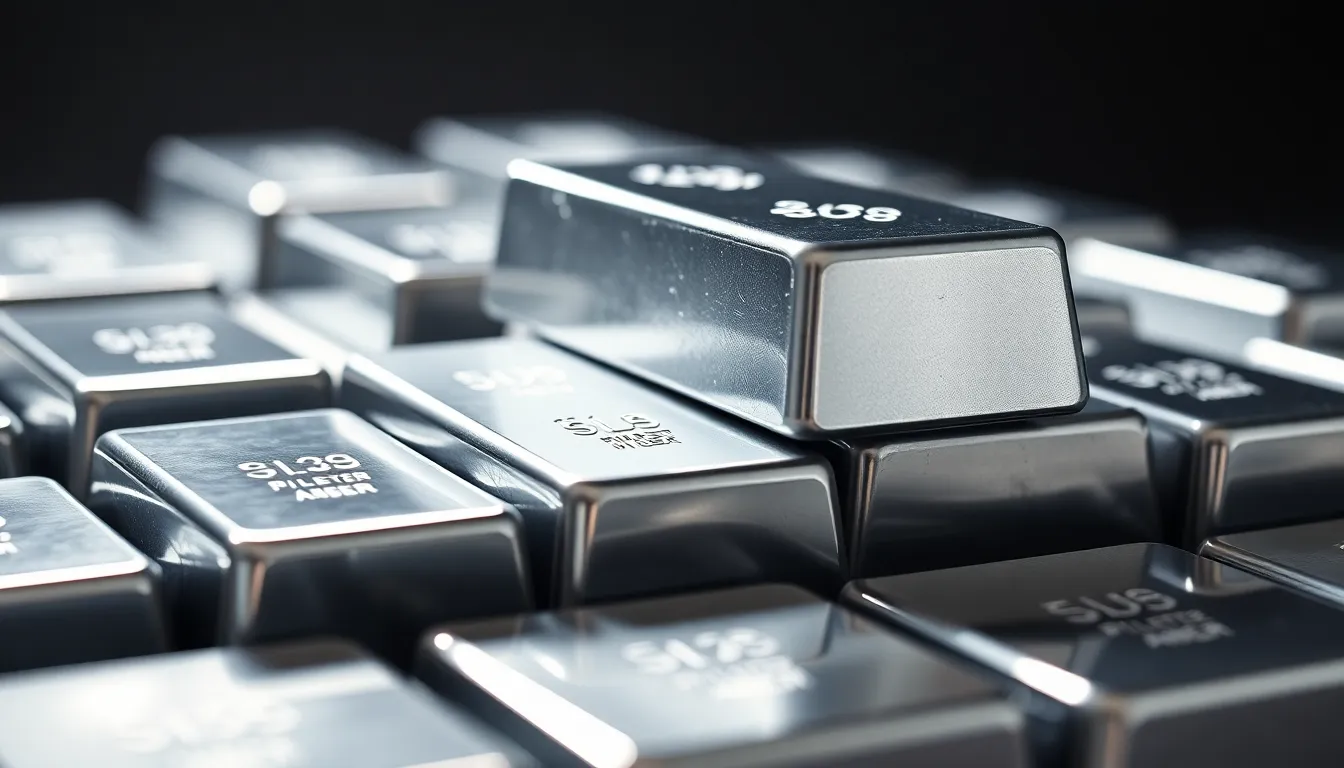Silver’s been the underdog of precious metals, often overshadowed by its flashy cousin gold. But don’t let its modest reputation fool you; silver’s got a bright future ahead. As industries embrace green technology and investors seek safe havens, the demand for silver is poised to soar.
Imagine a world where your silver stash isn’t just a shiny collection but a ticket to financial savvy. With predictions swirling around its price, now’s the time to hop on the silver train before it leaves the station. Whether you’re a seasoned investor or just dipping your toes, understanding where silver prices are headed could make all the difference. Buckle up as we dive into the crystal ball of silver price predictions and uncover what the future might hold for this gleaming metal.
Table of Contents
ToggleOverview Of Silver Market Trends
Silver’s market trends show a significant shift driven by industrial demand and investment interest. Increased utilization in green technology, such as solar panels and electric vehicles, fuels this demand. Analysts anticipate growth as more companies adopt sustainable practices, further elevating silver’s profile.
Economic uncertainty prompts investors to seek safe-haven assets. Rising inflation rates and geopolitical tensions contribute to silver’s appeal as a hedge against financial instability. The correlation between silver and gold prices often favors a bullish trend for silver during economic downturns.
Market volatility presents both risks and opportunities. Price fluctuations can attract traders looking for short-term gains, while long-term investors may view temporary dips as buying chances. Historical data shows that silver often outperforms during periods of heightened market unrest.
Investment trends indicate a growing interest in silver exchange-traded funds (ETFs). Increased inflows into silver ETFs reflect a shift towards diversified portfolios that include precious metals. This trend signals confidence in silver’s future potential as an investment vehicle.
The supply side also impacts silver prices. Decreasing mining outputs from key regions and rising production costs put upward pressure on prices. Analysts note that any disruption in supply chains could catalyze price surges.
Overall, the combination of industrial demand, safe-haven appeal, and supply constraints shapes silver’s market dynamics. Increased awareness of its value in both technology and investment strengthens the case for silver as a critical asset in future portfolios.
Factors Influencing Silver Prices

Factors influencing silver prices include various economic, supply, and geopolitical elements. Understanding these factors helps in predicting silver’s future value.
Economic Indicators
Economic indicators play a crucial role in shaping silver prices. Inflation rates often correlate with rising silver demand as investors seek protection against currency devaluation. Interest rates influence investment choices; lower rates typically lead to higher silver attractiveness since holding physical silver becomes less costly compared to interest-bearing assets. Additionally, GDP growth figures can indicate industrial demand, further impacting prices. The Consumer Price Index (CPI) serves as a reliable measure, often reflecting inflation trends. A rise in CPI usually boosts silver prices due to enhanced demand as a hedge.
Demand and Supply Dynamics
Demand and supply dynamics directly affect silver market fluctuations. Industrial applications drive approximately 50% of silver demand, particularly in electronics and renewable energy technologies. Solar panel production remains a significant growth factor. With increasing adoption of electric vehicles, silver requirements in this industry rise. On the supply side, operational challenges, like lower mining outputs due to depletion of existing mines and increasing extraction costs, constrict availability. The imbalance between rising demand and limited supply forecasts upward pressure on silver prices.
Geopolitical Factors
Geopolitical factors also substantially impact silver pricing. Regional conflicts and uncertainties often trigger safe-haven buying. Investors typically flock to silver during geopolitical tensions, boosting its value as they seek stability. Trade policies can directly influence market dynamics; tariffs or restrictions on silver imports can create price surges. Furthermore, government policies surrounding mining can affect supply chains. Notably, fluctuations in currency values, particularly the U.S. dollar, directly relate to silver’s appeal; a weakening dollar generally benefits silver prices.
Expert Predictions for Future Silver Prices
Silver’s price trajectory attracts significant attention from analysts and investors alike. Predictions point toward substantial growth, particularly influenced by industrial demand and market dynamics.
Short-Term Projections
Short-term predictions for silver prices focus on responses to economic indicators. Analysts expect fluctuations due to inflation rates, which tend to boost silver’s attractiveness as a hedge. Additionally, analysts anticipate increased demand from the renewable energy sector, especially solar technology. Supply constraints also play a critical role; as mining outputs decline and production costs rise, prices should witness upward pressure. Most projections suggest prices could reach the $30 per ounce mark within the next year based on these factors.
Long-Term Forecasts
Long-term forecasts indicate an even more optimistic outlook for silver. Experts anticipate that the demand for silver in emerging technologies will continue to grow, particularly in electric vehicle production and energy storage. Geopolitical tensions might contribute to a higher safe-haven appeal, driving investment further. By the end of the decade, some estimates place silver prices between $50 and $100 per ounce, reflecting its increasing role as an indispensable asset in investment portfolios. Furthermore, limited supply due to aging mines and the reliance on recycling for availability supports these projections.
Investment Strategies for Silver
Investing in silver presents several effective strategies. Investors can diversify their portfolios and take advantage of rising demand.
Buying Silver Bullion
Buying silver bullion represents a direct method to invest in silver. Physical silver, such as coins and bars, allows investors to hold tangible assets. The market often values bullion based on the current spot price. Premiums apply on top of this spot price depending on factors like rarity and demand. Possessing silver bullion provides a sense of security during economic instability. Investors should consider reputable dealers to ensure authenticity. Storing silver requires safety measures to prevent theft or loss. Diversifying quantities across different forms of bullion enhances investment resilience.
Investing in Silver ETFs
Investing in silver ETFs offers an accessible method for exposure to silver without holding physical metal. These funds trade on exchanges like stocks, allowing for easy buying and selling. Silver ETFs typically track silver’s price, reflecting market conditions. Many investors prefer these funds for ease of execution and liquidity. Management fees apply, but lower than costs associated with physical storage. Some ETFs focus on companies involved in silver mining, providing indirect exposure to silver prices. As a method of diversification, silver ETFs complement broader investment strategies. Market trends suggest increasing popularity as awareness of silver’s potential grows.
The future of silver looks bright as it positions itself as a key player in the investment landscape. With rising industrial demand and persistent economic uncertainties, investors are likely to find silver increasingly appealing. The expected price growth, combined with supply constraints, suggests that now may be an opportune time to consider silver as a valuable addition to investment portfolios.
As trends in technology and sustainability continue to evolve, silver’s role in these sectors will only strengthen. By staying informed and adapting investment strategies, individuals can capitalize on silver’s potential, ensuring they’re well-prepared for what lies ahead in the market.


